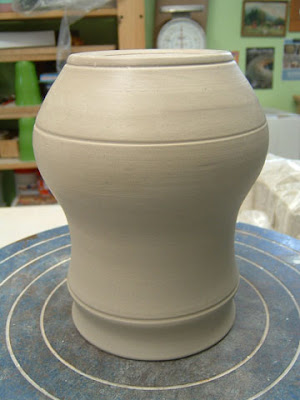
I started by cutting out stencils of a bird and 2 butterflies. When I've made stencils in the past I used clear plastic. Old clay bags work great for stencils because they are a heavy weight plastic. This time I tried tracing paper for the bird on a branch. Both materials worked fine. The benefit to the plastic stencils is they can be reused. I wet the stencils (this helps them stick and stay put) and placed them in position on the leather hard platter. Then I centered the platter on my potter's wheel.

Next as I slowly spun my wheel, I used a soft wide brush to apply the brown and black underglazes over the whole surface of the platter. I used Amaco LUG1 black underglaze and Mayco UG031 Chocolate underglaze. The stencils blocked out the areas I wanted to remain white. Clay slips work just as well with this process.

After the underglazes dried to the point of loosing their sheen, I peeled the stencils off.

I used my spinning wheel and a fine wire loop tool to cut some white lines into the black rim of the platter. My next step was to add more black plants on top of the brown background. I did this freehand with small brushes.

I let the piece dry for about 1 hour. Then I used my fine wire loop to carve through the layers of underglaze and reveal the white clay underneath. This technique is called scraffito. After this piece is bisque fired I will apply a clear glaze and fire it again to cone 6. When it is completed, the brown underglaze will turn a honey color and the black and white areas will be glossy. You can see examples of finished pieces using this technique in many of my earlier posts.


On Saturday I have two more platters to decorate. I haven't decided what I am going to do to them yet. Stay tuned...
























